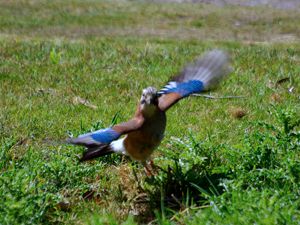


The most arboreal crow. The Jay can be found in pine plantations as well as its more normal haunt of deciduous woodland. It's widely distributed in Nottinghamshire and is common from Nottingham north to the forest area, although because of its shyness it is not regularly seen. It is more normally picked up by its harsh call.
In the nineteenth century the Jay was almost certainly not as common as it is in the present day, mainly because it was shot and trapped at any opportunity.
The Jay is sedentary, but there can be irruptions in some autumns, when its favourite food, the acorn fails. Three such recent irruptions of Jays noticeable in Nottinghamshire were in the autumns of 1983, 1996 and 2003.
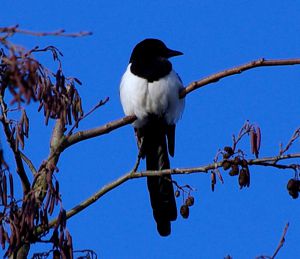
The Magpie is the best known and recognised British crow. The Magpie's distribution status is most definitely common and it can be found throughout Nottinghamshire. In the eighties it was rare in the forest area of Nottinghamshire – the Dukeries and surrounding areas, but now is as common in the farmland around there as anywhere in Nottinghamshire.
One often seen feature of the Magpie's behaviour is the ceremonial gatherings they have at the beginning of the year. These are though to be territorial disputes when the young of the previous year challenge the existing territory occupants. The noise and action attract other local Magpies who come along to watch.
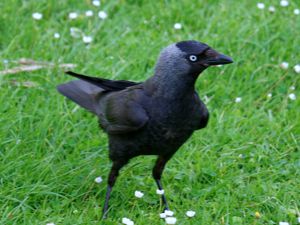
Another common crow, the Jackdaw is present in Nottinghamshire in large numbers. In the winter the Jackdaws feed in pastures, often with Rooks and roost colonially in woodland such as Attenborough and Wollaton Park. In the summer they are more widely spread, but nest communally in Nottinghamshire almost always in tree holes or buildings such as churches.
The Jackdaw has increased its numbers by around two–thirds in the past twelve years.(BBS index for the East Midlands). Sterland & Whitaker say in their A Descriptive List of the Birds of Nottinghamshire that the Jackdaw was numerous "particularly in Sherwood Forest, where it breeds by thousands in the hollow oaks".
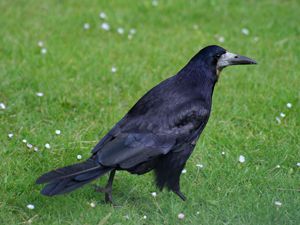
The Rook is another common crow in Nottinghamshire and its habits and behaviour are similar to the Jackdaw, in that it forages for food in fields in the winter and breeds in colonies, often with Jackdaws and Carrion Crows.
In the Birds of Sherwood Forest {1869}, Sterland says that the Rook was one of the commonest birds around. In Nottinghamshire the Rook reached a recent high of around 17,000 nests in 1958, but 20 years later the number of nests was down to one third of that (NBW annual report {1997}). In the 10 years since then the Rook population has increased by a third (BBS index for the East Midlands).
It feeds on animal and vegetable sources, in both pasture and arable fields
Although it can be found over most of Nottinghamshire it baulks at coming into the larger towns, but may be seen over flying them, especially in the late winter afternoons on their way to their roosts. This communal roosting behaviour breaks down in February as they move back to their rookeries to prepare to breed.
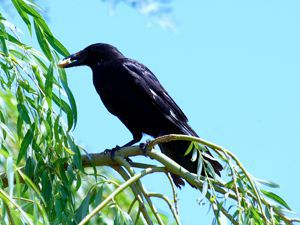
The Carrion Crow is classed in Nottinghamshire as a common resident, and can be found all over Nottinghamshire. The Carrion Crow has an omnivorous diet, from road kills to fruit cake, to insects and grubs – in fact anything, animal or vegetable, which is edible. They are a versatile and adaptive species and on the Beeston Canal the local Carrion Crows are capable of beating the Black-headed Gulls in taking bread off the water surface.
In the spring and summer the older and fitter birds form territories for breeding which they defend against the non-breeders. The Carrion Crow is a lot more sociable in the winter –feeding in fields with numbers sometimes reaching a hundred or so and sleeping together in large roosts. Britain's oldest known Carrion Crow was ringed in north Nottinghamshire as a chick in 1989 and was killed just over 15 years later a few miles away.
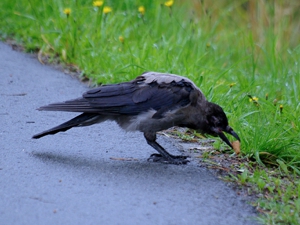
The Hooded Crow was last noted in Nottinghamshire in 1990, however Sterland in the Birds of Sherwood Forest {1869}, regarded it as a regular winter visitor between November and March. This presumably remained the case until the 1940s when its visits became much less frequent (The Birds of Nottinghamshire {1979} (Dobbs)). The decrease in its visits to Nottinghamshire are perhaps due to the warmer winters and the increasing tendency of Hooded Crows in Scandinavia to winter in the towns there. The population of Hooded Crows in northwest Scotland are mainly sedentary, whereas it is the northern Scandinavian population which is migratory.
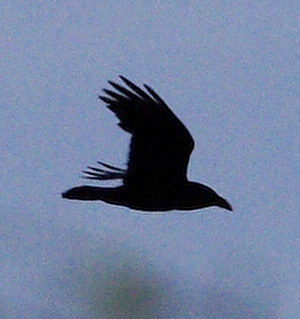
Quite possibly the Raven used to be a fairly common bird in Nottinghamshire, especially when agriculture developed a patchwork of arable and pasture fields along with woodland, but as Sterland says in the Birds of Sherwood Forest {1869} it was only a straggler in the mid–nineteenth century. On the keepered estates it would have been shot on sight from the end of the seventeenth century up to the mid–twentieth century.
In the last thirty years it has been increasing, especially in the Dukeries, and may now even breed there. The bird in the photograph on the left had just had an altercation with a Buzzard. This may have been a breeding territorial dispute or just a mutual dislike of one another as their food sources, carrion, voles, invertebrates, overlap.
Ravens in Britain do not move around between winter and summer, juveniles however will disperse from their parent's territory and it is presumably juveniles from neighbouring Derbyshire which are providing our birds. They were slower to move out of Wales than the Common Buzzard and their spread eastwards is slower because they prefer to "saturate" their existing territories before they explore new ones.
Any criticisms, corrections or comments to the author Derek Huskisson

This work is licensed under a Creative Commons Attribution-Noncommercial-Share Alike 2.0 UK: England & Wales License.